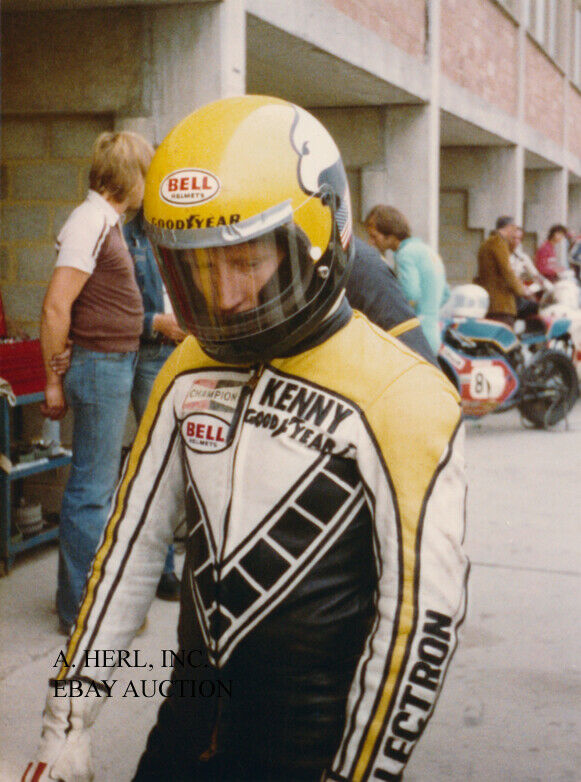-40%
Norton factory racer Sexe 1923 Paris-Nice motorcycle racing photo
$ 5.14
- Description
- Size Guide
Description
A superb and rare photo of the greatSexe
photographed shortly before the start of the 1923 Paris-Nice race.
The original
Norton
company was formed by James Lansdowne Norton (Known as Pa) in Birmingham in
1898. In
1902
Norton
began building motorcycles with French and Swiss engines. In
1907 a
Norton ridden by Rem Fowler won the twin-cylinder class in the first Isle of Man TT race, beginning a sporting tradition that went on until the 1960s – The Isle of Man Senior TT, the most prestigious of events, was won by Nortons ten times between the wars and then every year from 1947 to 1954. The first
Norton
engines were made in 1908, beginning a line of side-valve single cylinder engines which continued with few changes until the late 1950s. In 1913 the business declined, R.T. Shelley & Co., the main creditors, intervened and saved it. Norton Motors Ltd was formed shortly afterwards under joint directorship of
James
Norton
and
Bob
Shelley
.
J.L.
Norton
died in 1925 aged only 56, but he saw his motorcycles win the Senior and sidecar TTs in 1924.
Designed by
Walter
Moore
, the CamShaft One (CS1) engine appeared in 1927, based closely on the ES2 (pushrod) engine and using many of its parts. On his departure to NSU in 1930, an entirely new OHC engine was designed by
Arthur
Carroll
, which was the basis for all later OHC and DOHC Norton singles. (
Moore
's move to NSU prompted staff to claim that NSU stood for "Norton Spares Used") That decade spawned the
Norton
racing legend. Of the nine Isle of Man Senior TTs (500 cc) between 1931 and 1939
Norton
won seven. Up to 1934,
Norton
bought the excellent
Sturmey
Archer
gearboxes and clutches. When Sturmey decided to discontinue production,
Norton
bought the design rights, and had them made by Burman, a manufacturer of proprietary gearboxes.
Nortons
also appealed to ordinary motorcyclists who enjoyed the reliability and performance offered by single-cylinder engines with separate gearboxes. The marque withdrew their teams from racing in 1938, but between 1937 and 1945 nearly one quarter (Over 100,000) of all British military motorcycles were Nortons, basically the WD
16H
(solo) and WD Big Four outfit (with driven sidecar wheel). After the War,
Norton
reverted to civilian motorcycle production, gradually increasing the range. A major addition in 1949 was the Dominator, also known as the Model
7, a
pushrod 500 cc twin cylinder machine designed by
Bert
Hopwood
. Its chassis was derived from the ES2 single, with telescopic front and plunger rear suspension, and an updated version of the gearbox known as the 'horizontal' box. Post war,
Norton
struggled to reclaim its pre-WWII racing dominance, since the single cylinder machine was facing fierce competition from the multi-cylinder Italians, and AJS at home. In the 1949 Grand Prix motorcycle racing season, the first year of the world championship,
Norton
only made fifth place, and AJS won. That was before the
Norton
Featherbed
frame appeared, developed for
Norton
by the McCandless brothers of
Belfast
in January, 1950, used in the legendary Manx Norton, and raced by riders including
Geoff
Duke
,
John
Surtees
and
Derek
Minter
. Overnight the featherbed frame was the benchmark by which all other frames were judged.
Nortons
were winners again.
Norton
also experimented with engine placement, and discovered that moving the engine slightly up/down, forward/back, or even right/left, could deliver a "sweet spot" in terms of handling. In 1951 the Norton Dominator became available in export markets as the Model 88 with the Featherbed frame. Later, as production of this frame increased, it became a regular production model, and was made in variants for other models, including the ohv single cylinder machines. The racing successes were transferred to the street through Cafe racers, some of whom would use the feather bed frame with an engine from another manufacturer to make a hybrid machine with the best of both worlds. The most famous of these were Tritons - Triumph twin engines in a
Norton
feather-bed frame. Despite, or perhaps because of the racing successes,
Norton
was in financial difficulty. Reynolds could not make many of the highly desired featherbed frames, and customers lost interest in buying machines with the older frames
This is your rare chance to own this
non period
photo that reflects a very interesting and historic piece of motorcycle and Norton ’s history. Therefore it is printed in a nice large format of ca. 8" x 12" (ca. 20 x 30 cm).
Shipping costs will only be $ 7.00 regardless of how many photos you buy. For 5 or more photos, shipping is free!
(Note: A. Herl, Inc. does not appear on photo, for ebay purposes only)
No copyright expressed or implied. Sold as collectable item only. We are clearing out our archives that we have gathered from various sources.
All items always sent well protected in PVC clear files
and board backed envelopes.
We have photographs that came from professional collections and/or were bought from the original photographer or press studio! They are all of professional and excellent quality.
After many decades of professionally collecting photographs and posters we are clearing out our archives. They make the perfect gift and are perfectly suited for framing. They will look gorgeous unframed and will be a true asset nicely framed with a border. They are a gorgeous and great asset in every home, workshop, workplace, restaurant, bar or club!
First come - first served. And you can always contact us for your requests. Please ask any questions before the auction ends.









